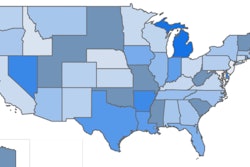
Though school debt consistently exceeded income for healthcare occupations -- except for physicians -- between 2017 and 2022, dentists had the highest debt-to-income ratios. The study was published in the American Journal of Pharmaceutical Education.
If rising education loan debt is not addressed, it may affect postgraduate training and career choices for students, specifically those from underrepresented populations, which could also hurt access to dental and other medical care, the authors wrote.
"We call upon health professions education programs to take bold action in developing and implementing innovative strategies to address student educational debt burden, as ameliorating debt burden may ultimately help facilitate improved access to health care," wrote coauthors Christina Spivey and Marie Chisholm-Burns of the office of the provost at Oregon Health & Science University in Portland (Am J Pharm Educ, July 4, 2024).
In the U.S., educational loan debt has doubled since 2000. Currently, student debt in the U.S. exceeds $1.7 trillion.
Furthermore, increases in average education debt surpass growth in tuition costs by more than 166%. The average student debt for graduate students not only exceeds $106,000, but more than 74% of students who graduate from professional programs have U.S. education loan debt, according to the study.
Given the significant rise in educational loan debt in recent years, a retrospective analysis was conducted from 2017 to 2022 for dentists, pharmacists, physicians, optometrists, and veterinarians.
Annual income data for those occupations were gathered from the American Community Survey, a yearly demographics survey conducted by the U.S. Census Bureau. Student debt information was gathered from professional organizations, including the American Dental Education Association and the American Association of Colleges of Pharmacy.
Of the health professions included in the study, dentists had the highest debt-to-income ratio in 2017 and 2022. In 2017, dentists had a student loan debt of $308,200 and an income of $152,811 (±5,666), which was a debt-to-income ratio of 2.02. In 2022, dentists had an educational loan debt of $286,200 and an income of $182,872 (±2,020), which was a debt-to-income ratio of 1.57, the authors wrote.
In 2017, physicians had student loan debt of $180,000 and an income of $204,335 (±1,029), which was a debt-to-income ratio of 0.88. In 2022, physicians had an educational loan debt of $200,000 and an income of $239,880 (±2,270), which was a debt-to-income ratio of 0.83, they wrote.
Optometrists, pharmacists, and veterinarians fell somewhere in the middle of those two professions in terms of debt and income.
However, between 2017 and 2022, dentists saw the biggest mean decrease per year (-0.09) in their debt-to-income ratio, and they were the only one of these occupations to experience a mean reduction per year in student educational debt (-$4,400), they wrote.
On the flip side, physicians experienced the highest mean increase per year ($4,000), as well as the largest mean rise per year in income ($7,109), between 2017 and 2021.
Regardless, the study was not without limitations, including that undergraduate debt was excluded from the analysis. Inclusion of that debt would raise individual student loan debt at varying amounts, the authors wrote.
As student loan debt remains dramatically high, a more aggressive approach may be necessary to counter this ongoing problem, they wrote.
"We therefore propose a call to action to higher education, and health professions programs in particular, to reduce the financial burden faced by our students," Spivey and Chisholm-Burns wrote.




















